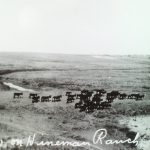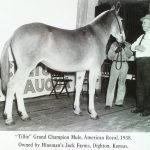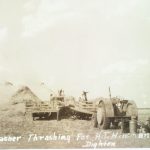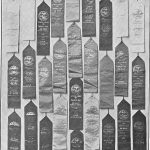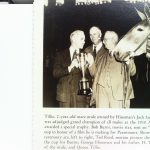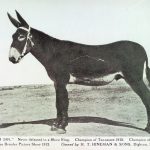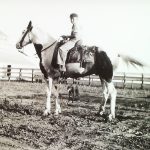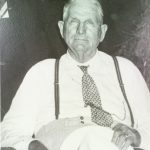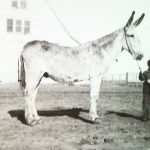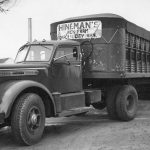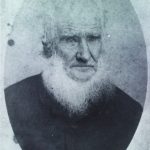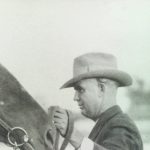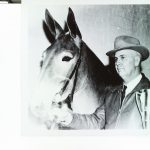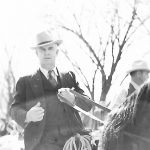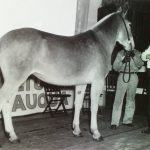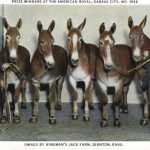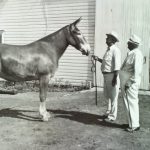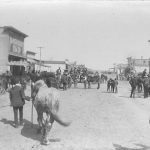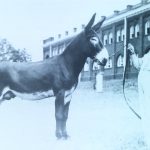The Hineman Family History – Courtesy of Kansas Pioneers
Herbert T. Hineman is one of the earliest settlers in Lane county, having entered his homestead there in 1885 and settled permanently in 1886. He and his young wife were conveyed to this pioneer home in a wagon which was drawn by Tom and Jerry, a most responsive yoke of oxen, with whom as Mr. Hineman has remarked, “we resided for over six years”. In addition to his team, and wagon he possessed two cows and $7.50 in cash.
Mr. and Mrs. Hineman resided on their homestead the NW quarter of 23-19-29 for five years. Their home consisted of two rooms made of sod and plastered with native lime.
In November, 1890,· they moved to their present home. On this farm he devoted himself to the raising of grain and feed, and to building up a herd of livestock, ,
particularly to the horse industry. The range was open open and a horse could be produced almost without cost.
Later, he began raising the pedigreed Percheron. Mr. Hineman has made a success with horses, but his greatest fame has come as a raiser of jacks. In 1904 he began this business by purchasing “Mammoth Jumbo”, and with this individual his line of noted jacks started. “Kansas Chief” won the world’s championship at San Francisco Exposition in 1915. Mr. Hineman exhibited eleven head of jacks and jennets there and won twenty-eight ribbons with them.
Mr. Hineman has a ranch of many hundred acres all fenced and cross fenced, and in addition to livestock is now growing large acreages of wheat. He is also largely interested in various business concerns in Dighton, Kansas. He was elected as sheriff of Lane county in 1902 and served in that capacity for four years, during which time there were but four juries empaneled and only one murder case tried. There was no jail at that time and no apparent need for one. To Mr. and Mrs. Hineman were born two children, George and Albert.
Mr. Hineman said recently in a speech at a pioneer settlers’ picnic: “Our pioneer days on the broad, expansive plains, where one could see for fifty miles in the distance, were the happiest days of my life.” He faltered. “No, I’ll take that back. When I look about me today and see the faces of my old friends and neighbors and see sitting close to my side the first teacher of my boys, Mrs. Isabel Wolf Johnston, whom we have always loved as one of our family, I think of her motherly care and fine moral and intellectual teaching. I am compelled to say, with my family and grandchildren all about me, these are my happiest days, and I feel the love of God and nearer to eternal happiness.”
The Hineman Family – Courtesy of the Lane County Historical Society
Herbert Talford Hineman was born on January 14, 1865, in Monroe County, Ohio. He went to school in Ohio and lived on a farm with his mother, Elizabeth, and stepfather, Samuel Stormont. Near their farm was a family by the name of Phillips, who had a family of ten children. Herbert met one of the daughters, Dora, and they fell in love and wanted to get married. Dora’s father would not give his consent and after waiting for a year or two, on April 8, 1885, Dora and Herbert got out the horse and rode together to the home of Reverend Ingles, eight miles away. They were married. Herbert was 20 and Dora was almost 20.
In July of that same year, Herbert and Dora said goodbye to their family and friends and set out for Kansas by train to make a new life for themselves. After arriving in Sterling, they went on to Stafford where an uncle of Dora’s lived . There they farmed and Dora worked in the hotel at Sterling. In October, Herbert went to Lane County to stake his claim, after which he went to the land office to file his claim. After ten days on the prairie and waiting to file his claim, he put his claim on record on October 13, 1885, on S23, T20, R29.
On April 7, 1886, one day before their first wedding anniversary, Dora and HT loaded their covered wagon and headed for their claim in Lane County . Their outfit consisted of six chickens, a team of oxen, two milk cows, some household equipment and dishes, and other things which were wedding presents, a little food, a plow, spade, hammer, ax and seed for planting, a cap and ball musket, $7.50 in cash and some $56 worth of indebtedness.
The first thing they did was to plow and break the sod; then planted their crop. After which, they turned their attention to building a sod house. Their sod house was 18X21 ft. with an additional 16X17 board floor and roof At the age of 21, Herbert drove the 11 1/2 miles, a two day trip to Dighton, to cast his first vote . The vote was in favor of organizing the county of Lane.
At the end of five years on their claim, in I 890 , H.T. proved up on his homestead . Since there was not a good water supply there, he disposed of that land and bought a relinquishment on a timber claim of 320 acres on the SW of S5-R19-T28. There was water here and it was one mile east and 3 l /2 miles south of Dighton . This was H.T. and Dora’s last move to the spot where they would spend the rest of their life.
In the spring of 1891, there was not much moisture and Dora and others were very discouraged, but H.T. was determined to stick it out. They lost all of their baby chicks that year, but the wheat did produce . In 1892 , they were able to buy a small frame house and move it next to the sod house.
On January 13, 1892, their second son, John Albert was born. A little daughter was born in· 1894 , but she died at birth. During George and Albert’s early days, they actively participated on the Dighton baseball team.
Herbert, Dora, and their sons , George and Albert. Photo is from around 1911-1917 .
In 1899 , H.T. Hineman purchased a few jacks and thirty jennets and he began producing stock for himself and surrounding farmers.
This was the beginning of what widely became known as the Hineman Jack Farm. The Hineman Farm was at first called the Hineman Ranch, later the Hineman Stock Farm and the Fairview Stock Farm. Later it was called the Hineman Jack Farm.
Soon H.T. started going to fairs and exhibiting. He found that the best way to improve a herd was to buy the very best jack that could be bought and so in 1904, he bought Mammoth Jumbo. They continued to exhibit and go to shows and in 1915, H.T. and his son , George took eleven jacks and jennets to the San Francisco World’s Fair. It was there that Kansas Chief from the Hineman Farm won the title of World’s Champion Jack.
From that time on until 1947, H.T. and George took their jacks, jennets, and mules to state fairs around the country. Sometimes they would even divide the livestock into two groups, one man taking part of the stock to some fairs and the rest to other fairs. They showed many prize winning mules across the country. Their mare mule Dixie became the only mule ever to win the American Royal competition for three years. By 1918, the buildings were Delco-lighted, furnishing current for barns and residences, laundry, churning, and separating of milk and cream in the “milk house”. The farm was dotted with barns, sheds, and windmills with more being added . Large livestock barns were built on the farm and they started having their livestock auctions there. (Previously, H.T. and DJ. Hutchins had held auctions together at Sterling.) Livestock auctions were held at the Hineman Jack Farm for several years, drawing buyers from many states. They also sold Percheron draft horses.
By 1934, HT. and his sons ran a 5000 acre ranch. In an article of 1934 by E.E. Kelley of the Topeka Capitol, he tells of visiting the nation’s largest mule farm in Lane County. There was seven of them that visited and toured the farm that day and were dinner guest. He stated, “Our crowd was expected. Mrs. Hineman had ready a turkey dinner. It was a dinner of the kind that I suppose belonged to days gone by; such a plenty and such a variety. The food was served by a colored maid in uniform. Her husband is caretaker of some of the jacks and mules.) NOTE: Some will remember Bill and Ethel Briscoe and another article states that Bill was with the Hineman’s for a substantial part of the 50 years that they have been in the jack raising business.
In 1935, Herbert and Dora celebrated their 50th wedding anniversary. In an article about the Colonel and Dora, H.T. stated that working together was the key to their success. “There will be no you and I in our family, only us. We will stick together and work together.” No man can claim all the glory of his success for it is the encouragement of a good helpmate to always go forward and never turn back, that leads him to the top. Thru the will of God and good fortune the one-time family of two has branched out to be a family of 15, still working together.”



